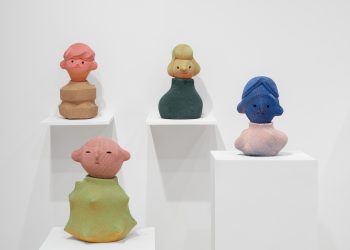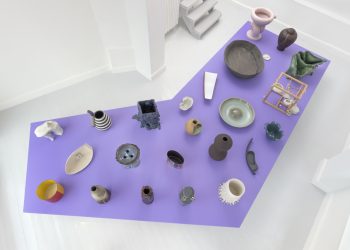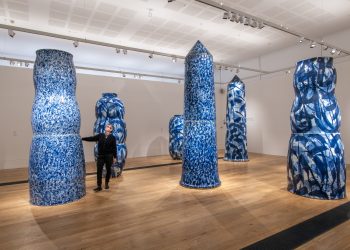














Sayaka Oishi Solo Exhibition is on view at Shinjuku Takashimaya Art Gallery, Tokyo
May 22 – June 3, 2024
Shinjuku Takashimaya Gallery is delighted to present Sayaka Oishi’s solo exhibition in Tokyo.
Sayaka Oishi was born in Kyoto. While studying ceramics at university, she became fascinated by decorative art forms around the world. She thinks that decoration is the essence of beauty and is the fundamental art form that expresses the connections of this world and people’s complex emotions. With over twenty years of dedication to ceramics and decoration, she has received awards and built collections both in Japan and abroad.
“I impromptu transform fleeting images into decorations. In these decorations, abstractions and concretions, humans and flora and fauna, as well as inanimate objects, all intermingle without discrimination. This is because the unique Japanese animism in me unconsciously manifests itself. Throughout history, decoration has consistently been a means of expressing societal, cultural, and individual thoughts. I hope my decorations serve as ‘my testament of living in the present’ and touch the hearts of those living in the same era.”
Explorer of the Essence of Decoration
Text by Hanazato Mari (Curatorial Section Manager of Ibaraki Ceramic Art Museum)
Oishi Sayaka has the formative ability to express a splendid world filled with rich decoration. Various colors, multifarious shapes, and different textures integrated into one artwork don’t let the viewer’s eyes stay in one place. Like my consciousness mixing or its accelerated flow, my heart also moves dizzyingly while I follow many elements that Oishi uses.
For example, exhibits this time titled “Sensitive apple – bone -” “Sensitive apple – new era –” are the latest works among the series Oishi has continued to create and around the core of an apple where there was flesh, relief-like or three-dimensional decorative items seem to be deeply connected as decoration.
The number of items accounts for more than 150 by a quick count, and there are a variety of stock, various sizes, and scales, including animals like a dog, a cat, a lion’s head, a bird, parts of body like a skull, an ear, a nose and a mouth mask, a hand, a leg, botanical parts that remind me of a flower, a leaf, a sprout, or a gear, a pistol, a vessel like an egg stand, parts made from the mold of wall decoration souvenir from Italy where she stayed about two years ago, or a chrysanthemum or a plum made from the Japanese sweets mold she has obtained recently.
When I visited her studio several months ago, the “new era” form was almost completed, and “bone” was getting started. How to make forms varies depending on the items and can be either hand-building or using molds. The human body and animals were made smoothly, taking advantage of clay plasticity, while hard objects such as a pistol, a gear, and a vessel were expressed in that way. Plants were made lightly, the molded items had sharp edges and the texture of each item was delicately expressed.
According to Oishi, various coloring, including black, handling decorative slip and glaze, and the texture expression have been carried over to the finished work. On the other hand, it was my surprise to learn that what she valued when putting items together was not the meaning or story nature of the items but the relationship between the shapes and the inspiration. I understood that instantaneously, so to speak, with a light sense, creation was progressing.
However, I do not think the use of the word “light” is appropriate. The structure and balance decision connected with the critical process, including firing, leading to the work creation, has been made more quickly through accumulated experiences. This shows instantaneity. Moreover, it seems that instantaneity enhances her concentration level during creation. Immersing herself in decorating her favorite apples with her favorite items would encourage her to express her heart and emotions under consciousness.
She considers “decoration” as the essence of formative expression. I agree with her, but in the heyday of modernism, decoration was considered as an extra thing with a negative meaning, handled like a supporting role to the essence. However, if we change the perspective, Jomon pottery, decorated ancient tombs, or the patterns on Chinese bronzeware also represented wishes, fears, and prayers. “Decoration” can be said to be proof of life.
I’m looking forward to visiting her exhibition to see how I would accept this wave of “decoration” to the theme that she has continued to pursue, the 2 completed “sensitive apples” and the first exhibition titled “Yin and Yang”.
Contact
https://www.takashimaya-global.com/en/stores/shinjuku/
Shinjuku Takashimaya Gallery
5-24-2 Sendagaya
Shibuya-ku, Tokyo 151-8580
Japan


















